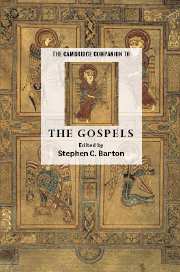Book contents
- Frontmatter
- Introduction
- Part I Approaching the gospels: context and method
- 1 What is a gospel?
- 2 The fourfold gospel
- 3 The canonical matrix of the gospels
- 4 The gospels and ‘the historical Jesus’
- 5 The gospels and the reader
- Part II The gospels as witnesses to Christ: content and interpretation
- Part III The afterlife of the gospels: impact on church and society
1 - What is a gospel?
from Part I - Approaching the gospels: context and method
Published online by Cambridge University Press: 28 January 2007
- Frontmatter
- Introduction
- Part I Approaching the gospels: context and method
- 1 What is a gospel?
- 2 The fourfold gospel
- 3 The canonical matrix of the gospels
- 4 The gospels and ‘the historical Jesus’
- 5 The gospels and the reader
- Part II The gospels as witnesses to Christ: content and interpretation
- Part III The afterlife of the gospels: impact on church and society
Summary
What is a gospel? In many ways the question echoes the one posed by Jesus in the gnostic Gospel of Thomas: Make me a comparison, tell me what I am like. Peter and Matthew both take the question at its face value. They look for points of comparison in the two intersecting cultural worlds of the gospels. Matthew's comparison uses the categories of the Greek world: Jesus is a philosopher, a kind of intellectual holy man, a guru. Peter's answer belongs to the cultural world of the Bible, invoking a model of holiness that is at once moral (faithful to the Law) and supernatural: Jesus is a righteous angel, a messenger sent direct from God. But Thomas resists the temptation to look for cultural analogies. For him, Jesus is sui generis, he is simply himself; he is not 'like' anyone else. And Thomas's reward is to be taken aside and given an insight into the hidden wisdom that Jesus whispers to the chosen few. The only trouble is, the secret gnõsis he gains is so extraordinary, so far removed from human categories of understanding, that he will never be able to communicate it to anyone else: 'Now when Thomas came back to his companions, they asked him, What did Jesus say to you? Thomas said to them, If I tell you one of the words that he said to me, you will take up stones and cast them at me, and a fire will come forth from the stones and burn you up.'
- Type
- Chapter
- Information
- The Cambridge Companion to the Gospels , pp. 13 - 33Publisher: Cambridge University PressPrint publication year: 2006
- 4
- Cited by

